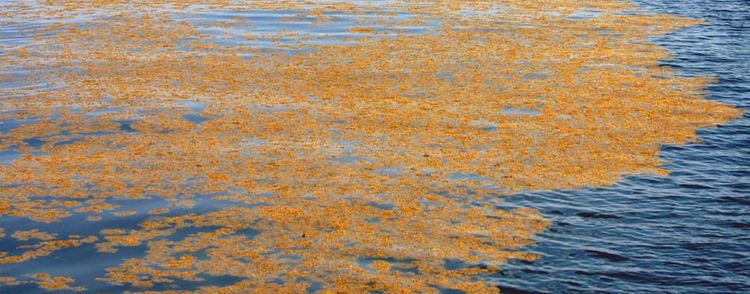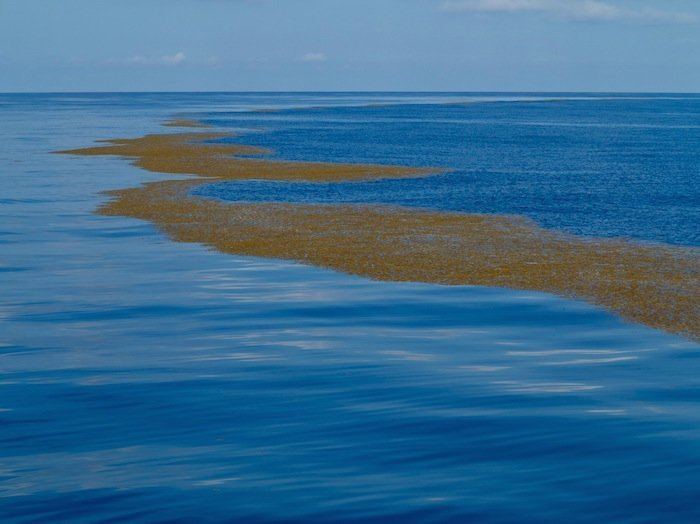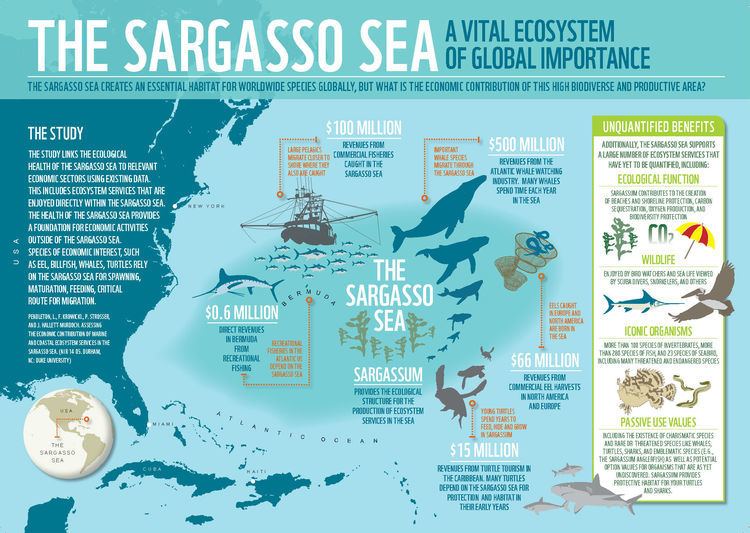 | ||
Big changes in the sargasso sea
The Sargasso Sea is a region of the North Atlantic Ocean bounded by four currents, that together form a circulating ocean stream called a gyre. It is the only such oceanic region on Earth to which the term sea has been extended, all others being bound entirely or mostly by land. A distinctive body of water often found with its characteristic brown Sargassum seaweed and often calm blue water, it is very different from the rest of the Atlantic Ocean.
Contents
- Big changes in the sargasso sea
- Sailing the bermuda triangle and the sargasso sea
- History
- Ecology
- Pollution
- Depictions in popular culture
- References

The sea is bounded on the west by the Gulf Stream, on the north by the North Atlantic Current, on the east by the Canary Current, and on the south by the North Atlantic Equatorial Current, a clockwise-circulating system of ocean currents termed the North Atlantic Gyre. It is expansive, stretching from roughly 70 degrees west to 40 degrees west, and from 20 degrees north to 35 degrees north, giving it approximate dimensions of 1,100 km wide by 3,200 km long (700 statute miles wide by 2,000 statute miles long). Bermuda is near the western fringes of the sea.

All the currents deposit the marine plants and refuse they carry into this sea, yet the ocean water in the Sargasso Sea is distinctive for its deep blue color and exceptional clarity, with underwater visibility of up to 61 m (200 ft). It is also a body of water that has captured the public imagination, and so is seen in a wide variety of literary and artistic works and in popular culture.

Sailing the bermuda triangle and the sargasso sea
History

The naming of the Sargasso Sea after the Sargassum seaweed traces back to the early 15th-century Portuguese explorations of the Azores Islands and of the large "volta do mar" (the North Atlantic gyre), around and west of the archipelago, where the seaweed was often present. However, the sea may have been known to earlier mariners, as a poem by the late 4th-century author Rufus Festus Avienus describes a portion of the Atlantic as being covered with seaweed, citing a now-lost account by the 5th-century BC Carthaginian Himilco the Navigator.
In 1846 Edward Forbes hypothesized a post-Miocene land mass extending westward from Europe into the Atlantic:

If this land existed it did not extend to America (for the fossils of the Miocene of America are representative & not identical): where then was the edge or coastline of it, Atlantic-wards? Look at the form & constancy of the great fucus-bank & consider that it is a Sargassum bank.
Ecology

The Sargasso Sea is home to seaweed of the genus Sargassum, which floats en masse on the surface there. The sargassum is not a threat to shipping, and historic incidents of sailing ships being trapped there are due to the often calm winds of the horse latitudes.
The Sargasso Sea also plays a major role in the migration of both the European eel and the American eel. The larvae of both species hatch there and go to Europe or the East Coast of North America. Later in life, the matured eel tries to return to the Sargasso Sea to spawn and lay eggs. It is also believed that after hatching, young Loggerhead sea turtles use currents, such as the Gulf Stream to travel to the Sargasso Sea, where they use the Sargassum as cover from predators until they are mature.
In the early 2000s, the Sargasso Sea was sampled as part of the Global Ocean Sampling survey, to evaluate its diversity of microbial life through metagenomics. Contrary to previous theories, results indicated the area has a wide variety of prokaryotic life.
Pollution
Owing to surface currents, the Sargasso accumulates a high concentration of non-biodegradable plastic waste. The area contains the huge North Atlantic Garbage Patch.
Several nations and nongovernmental organizations have joined together to protect the Sargasso Sea. These organizations include the Sargasso Sea Commission established on 11 March 2014 by the governments of the Azores (Portugal), Bermuda (United Kingdom), Monaco, United Kingdom and the United States.
Bacteria have been found in the plastic-polluted waters of the Sargasso sea that consume plastic; however, it is unknown whether these bacteria ultimately clean up poisons or simply spread them elsewhere in the marine microbial ecosystem. Plastic debris can absorb toxic chemicals from ocean pollution, potentially poisoning anything that eats it.
Depictions in popular culture
The Sargasso Sea is often portrayed in literature and the media as an area of mystery.
The Sargasso Sea features in classic fantasy stories by William Hope Hodgson, such as his novel The Boats of the "Glen Carrig" (1907), Victor Appleton's Don Sturdy novel Don Sturdy in the Port of Lost Ships: Or, Adrift in the Sargasso Sea, and several related short stories. Jules Verne's Twenty Thousand Leagues Under the Sea describes the Sargasso Sea and gives an account of its formation.
Fred Andrew's mystery novel, Plato's Pond, features the fictitious land of Gaia, which is a continent in the middle of the Sargasso Sea.
Jean Rhys's novel Wide Sargasso Sea (1966) is set in the Caribbean during the midpoint of the nineteenth century.
The Young James Bond novel by Charlie Higson, SilverFin (2005), includes a chapter entitled Sargasso Sea, in which, the villain describes the eel migration.
